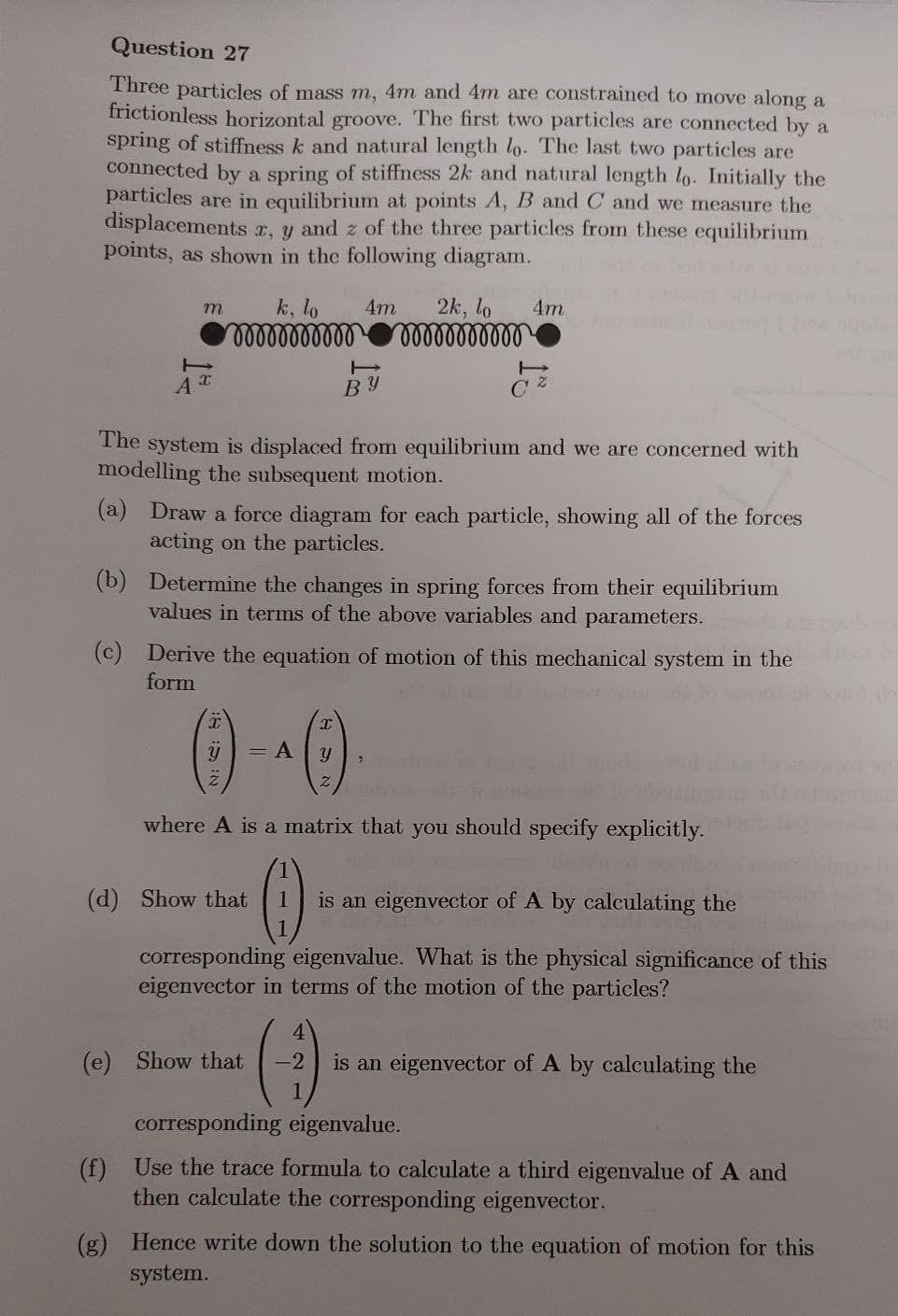Three particles of mass m, 4m and 4m are constrained to move along a frictionless horizontal groove. The first two particles are connected by a spring of stiffness k and natural length lo. The last two particles are connected by a spring of stiffness 2k and natural length lo. Initially the particles are in equilibrium at points A, B and C and we measure the displacements x, y and z of the three particles from these equilibrium points, as shown in the following diagram. m Ax k, lo mrrrrrrrrr The system is displaced from equilibrium and we are concerned with modelling the subsequent motion. (a) Draw a force diagram for each particle, showing all of the forces acting on the particles. 4m 2k, lo 4m mm m m m m m m m m (b) Determine the changes in spring forces from their equilibrium values in terms of the above variables and parameters. (c) Derive the equation of motion of this mechanical system in the form (d) Show that T BY (1) where A is a matrix that you should specify explicitly. () 1 is an eigenvector of A by calculating the = A I y Z (e) Show that corresponding eigenvalue. What is the physical significance of this eigenvector in terms of the motion of the particles? (-).. -2 is an eigenvector of A by calculating the corresponding eigenvalue. (f) Use the trace formula to calculate a third eigenvalue of A and then calculate the corresponding eigenvector. E (g) Hence write down the solution to the equation of motion for this system.
Three particles of mass m, 4m and 4m are constrained to move along a frictionless horizontal groove. The first two particles are connected by a spring of stiffness k and natural length lo. The last two particles are connected by a spring of stiffness 2k and natural length lo. Initially the particles are in equilibrium at points A, B and C and we measure the displacements x, y and z of the three particles from these equilibrium points, as shown in the following diagram. m Ax k, lo mrrrrrrrrr The system is displaced from equilibrium and we are concerned with modelling the subsequent motion. (a) Draw a force diagram for each particle, showing all of the forces acting on the particles. 4m 2k, lo 4m mm m m m m m m m m (b) Determine the changes in spring forces from their equilibrium values in terms of the above variables and parameters. (c) Derive the equation of motion of this mechanical system in the form (d) Show that T BY (1) where A is a matrix that you should specify explicitly. () 1 is an eigenvector of A by calculating the = A I y Z (e) Show that corresponding eigenvalue. What is the physical significance of this eigenvector in terms of the motion of the particles? (-).. -2 is an eigenvector of A by calculating the corresponding eigenvalue. (f) Use the trace formula to calculate a third eigenvalue of A and then calculate the corresponding eigenvector. E (g) Hence write down the solution to the equation of motion for this system.
International Edition---engineering Mechanics: Statics, 4th Edition
4th Edition
ISBN:9781305501607
Author:Andrew Pytel And Jaan Kiusalaas
Publisher:Andrew Pytel And Jaan Kiusalaas
Chapter7: Dry Friction
Section: Chapter Questions
Problem 7.48P: Find the smallest distance d for which the hook will remain at rest when acted on by the force P....
Related questions
Question
Plz solve only 4 parts within 1 hour i have to submit it to my professor i will definitely upvote plz

Transcribed Image Text:Question 27
Three particles of mass m, 4m and 4m are constrained to move along a
frictionless horizontal groove. The first two particles are connected by a
spring of stiffness k and natural length lo. The last two particles are
connected by a spring of stiffness 2k and natural length lo. Initially the
particles are in equilibrium at points A, B and C and we measure the
displacements x, y and z of the three particles from these equilibrium
points, as shown in the following diagram.
m
k, lo
mmmmmmmmmm
4m 2k, lo
mo o o o o o o o o o
A *
The system is displaced from equilibrium and we are concerned with
modelling the subsequent motion.
4m
BY
(a) Draw a force diagram for each particle, showing all of the forces
acting on the particles.
(d) Show that
C²
(b) Determine the changes in spring forces from their equilibrium
values in terms of the above variables and parameters.
(c) Derive the equation of motion of this mechanical system in the
form
()--()
= A y
where A is a matrix that you should specify explicitly.
()
1 is an eigenvector of A by calculating the
(e) Show that
corresponding eigenvalue. What is the physical significance of this
eigenvector in terms of the motion of the particles?
(-).
corresponding eigenvalue.
(f) Use the trace formula to calculate a third eigenvalue of A and
then calculate the corresponding eigenvector.
is an eigenvector of A by calculating the
(g) Hence write down the solution to the equation of motion for this
system.
Expert Solution
This question has been solved!
Explore an expertly crafted, step-by-step solution for a thorough understanding of key concepts.
Step by step
Solved in 4 steps with 4 images

Knowledge Booster
Learn more about
Need a deep-dive on the concept behind this application? Look no further. Learn more about this topic, mechanical-engineering and related others by exploring similar questions and additional content below.Recommended textbooks for you

International Edition---engineering Mechanics: St…
Mechanical Engineering
ISBN:
9781305501607
Author:
Andrew Pytel And Jaan Kiusalaas
Publisher:
CENGAGE L

International Edition---engineering Mechanics: St…
Mechanical Engineering
ISBN:
9781305501607
Author:
Andrew Pytel And Jaan Kiusalaas
Publisher:
CENGAGE L